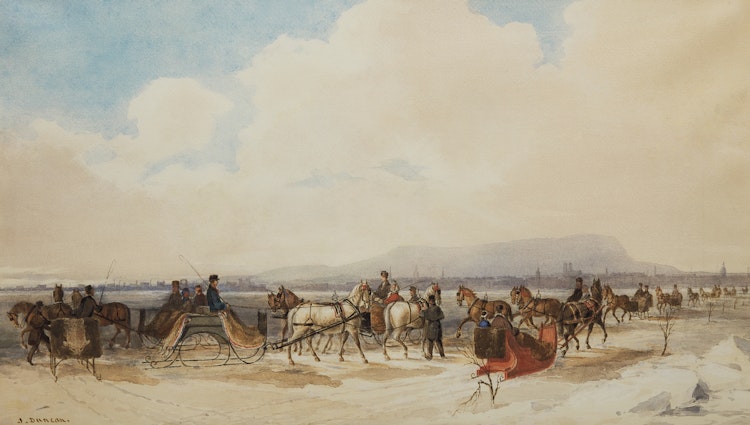Sleighing on the St. Lawrence, 1846 by James Duncan

James Duncan
Sleighing on the St. Lawrence, 1846
watercolour and gouache over graphite on paper
signed lower left
15.5 x 26 in ( 39.4 x 66 cm ) ( sight )
Auction Estimate: $8,000.00 - $12,000.00
Price Realized $22,800.00
Sale date: November 27th 2024
Walter Klinkhoff Gallery, Montreal
Acquired by the present Private Collection, June 1981
"Collector’s Canada: Selections from a Toronto Private Collection", Art Gallery of Ontario, Toronto; travelling to Musée du Québec, Quebec City; Vancouver Art Gallery; Mendel Art Gallery, Saskatoon, 14 May 1988‒7 May 1989, no. 7 as "Sleighing on the St. Lawrence", circa 1850
"James Duncan (1806-1881), Painter of Montreal", McCord Stewart Museum, Montreal, 2023 as "Sleighing on the St. Lawrence", 1846
Dennis Reid, "Collector’s Canada: Selections from a Toronto Private Collection", Toronto, 1988, no. 7, reproduced page 19
Laurier Lacroix and Suzanne Sauvage, "James Duncan (1806-1881), Painter of Montreal", Montreal, 2023, reproduced pages 156-157
James Duncan recruited many of his clients from among the city's elite, and was well-acquainted with their customs. This spectacular view portrays elegant sleighs fitted with fine metal blades adapted for gliding on ice surfaces. They cross paths with low sleighs driven by local residents, unlike the others, which are led by a coachman.
This panoramic view emphasizes Montreal’s diversity, showcasing the range of social classes demonstrated by the types of sleighs. The residential and business areas of the city, with its dominant church steeples and the silhouette of Bonsecours Market, are juxtaposed with the industrial sector, where chimneys rise along the Lachine Canal on the left side of the composition.
We extend our thanks to Laurier Lacroix, C.M., art historian, for researching this artwork and for contributing the preceding essay.
Share this item with your friends
James Duncan
(1806 - 1881)
James D. Duncan, artist and drawing master (b at Coleraine, Ireland 1806, d at Montréal Sept 1881). He emigrated to Canada about 1830, and established himself in Montréal as a professional artist and teacher of drawing.
Duncan is best known as a painter in watercolour. His many works in this medium are landscapes and street scenes which record every aspect of city life. In Montréal he sketched sporting events, parades, fires, market vendors, sleighing and ice-cutting. He also portrayed most of the city's important buildings. Through his brushwork and his use of a subtle range of colours, he captured atmospheric and textural effects. His on-the-spot sketches of figures and groups in action show him to have been an accomplished draftsman. Less frequently, he painted small watercolour portraits.
The few oil paintings attributed to Duncan vary in style and lack the fluidity and fine colour sense seen in his watercolours. Between 1839 and 1878, over 70 of Duncan's compositions were printed as etchings, lithographs or wood engravings. His views were used to illustrate Hochelaga Devicta: The Early History and Present State of the City and Island of Montréal (1839) and to decorate the borders of a Montréal map (1846). The most notable set of single-sheet prints are 6 Montréal views drawn on stone by Duncan and issued in 1843-44. They were the first tint-stone lithographs published in Canada. Duncan also created designs for coinage and for ornamental printing.
Duncan taught drawing at several Montréal schools and gave private lessons. Some pupils copied his works. In 1837 he served as a 1st lieutenant in the Montréal Light Infantry. He was a founding member of the Montreal Society of Artists in 1847 (seeARTISTS' ORGANIZATIONS), exhibited at the Québec Provincial Exhibition, Montréal, 1863-65, at the Art Association of Montreal, 1865-79, the Society of Canadian Artists, 1867-72, and became an Associate of the Royal Canadian Academy of Arts in 1881.

